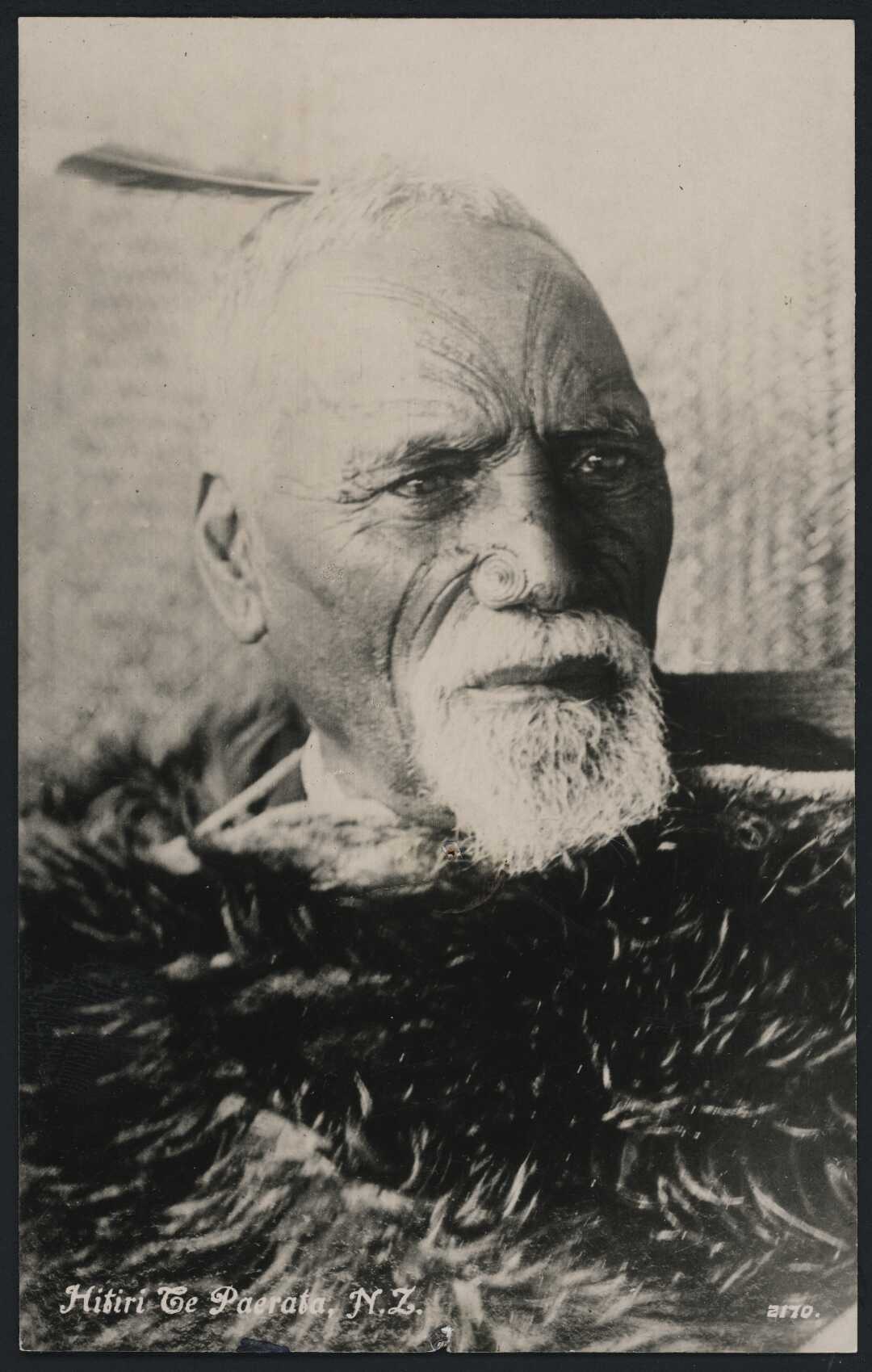The Kīngitanga
In the early 1850s, Wiremu Te Rauparaha and Matene Te Whiwhi, both with connections to Raukawa, were at the forefront of discussions about establishing a Māori King. As the Raukawa chief, Hitiri Te Paerata, explained in 1888, the Kīngitanga movement was considered by some to be the best way to deal with problems relating to the way ancestral lands were being alienated. These problems included, among other things, the low prices the Crown paid for Māori land, insufficient acknowledgement of chiefly mana, and the chiefs’ ability to sell “lands belonging to the people”.
Hitiri said that in supporting the Kīngitanga, Māori wanted “to set up a head whose mana was to overshadow the land and protect it”.
Raukawa was drawn into the movement through their whakapapa connections to other tribal groups and because of the benefits the Kīngitanga promised for Māori. In 1856, at the Hīnana ki Uta, Hīnana ki Tai hui at Pūkawa, Māori present agreed that a King was needed to rule over a confederation of tribes. In 1858, Pōtatau Te Wherowhero was selected for the role.
Kingiitanga – Paraone Gloyne, Robert Joseph and Des Tata
The Crown came to view the Kīngitanga movement as a challenge to the Queen’s sovereignty and sought to undermine the mana of the King.
In May 1861, Governor Thomas Gore Browne demanded iwi of the Waikato accept the Queen’s authority and obey her laws. In return, the Governor reaffirmed the Crown’s commitment to the protection of Māori possession of their lands and property as set out in the Treaty. He demanded that Māori be able to sell land to the Crown without interference from others, and permit roads and bridges to be built when required.
In September 1861, having returned to power, Governor Grey soon put forward his proposals for “new institutions” that would give Māori a greater role in local administration and which were in part designed to restrict the appeal and influence of the Kīngitanga.
Following the wars of the 1860s, the Crown sought to detach Raukawa from the Kīngitanga. While the Kīngitanga opposed the construction of roads and the work of surveyors within Te Rohe Pōtae, from the early 1870s the Crown sponsored these activities within the parts of the Raukawa takiwā that lay outside of Te Rohe Pōtae. After intense negotiations in the early 1870s, some of Raukawa accepted the Crown’s request to construct roads, but others remained loyal to King Tāwhiao
Raukawa were effected by the New Zealand wars in three main theatres, Taranaki, Waikato and Tauranga. The most notable battle encompassed Ō- Rākau in 1864, plus the British army campaigns in Tauranga which included the battles of Gate Pā and Te Ranga (also 1864).
In addition to these theatres of war, Raukawa were effected by the conflict between the Crown and Te Kooti in 1869-1870.
In regards to the Waikato war, Crown forces invaded the Waikato on 12 July 1863 when General Cameron and his army crossed the Mangatawhiri stream into the Waikato proper.
“On 9 December 1863, the British army occupied Ngāruawāhia and the situation in the Waikato became even more threatening. Kīngitanga forces retreated further south and did their best to construct a new defensive line to prevent the British army from reaching their main objective, the rich farming land around Rangiaowhia. ”
Rangiaowhia was vitally important to the people of the area because it was a centre of economic growth and trade. The market gardens supplied much of the produce sold in Auckland and afar.
Raukawa believe that when the Crown attacked Rangiaowhia on 21 February 1864, a massacre of refugees and non-combatants occurred. Accounts of the massacre saw Crown forces including militia unload a barrage of gunfire into the village, trapping the villagers within their whare.
The battle at Ō-Rākau began in earnest on the 31 March 1864 and concluded on the 2 April 1864. Leading the first British attack on Ō-Rākau was Brigadier-General G. J Carey, who was met with heavy resistance from the pā.
Waikato Campaign – Robert Joseph, Nigel Te Hiko, Paraone Gloyne, Anthony Pecotic, Kiriupokoiti Heke (Koro Gin)
Hitiri despaired
“It became a forlorn hope with us; none expected to escape, nor did we desire to; were we not all the children of our parent? Therefore, we all wished to die together.”
After failing to take the pā through a direct assault, Carey decided to lay siege to it. General Cameron arrived boosting the Crown’s forces to well over 1400 troops that fully surrounded the pā.
By the 2 April 1864, it became clear that the pā would fall. This prompted Cameron to offer terms of surrender.
Afterwards, some of the Raukawa survivors made their way south towards the safety of the King Country or to Taupō. Others made their way to Tauranga, where they unfortunately found themselves in the middle of a further theatre of war.
Following Ō-Rākau General Cameron moved his headquarters to Tauranga on 21 April 1864. On 26 April, the Battle of Pukehinahina (Gate Pā) took place.
The British army was soundly defeated, losing 10 officers and 25 men killed.
Pukehinahina & Te Ranga – Nigel Te Hiko, Des Tata (Ngāti Ranginui)
Some Raukawa also fought at Gate Pā including prominent Raukawa chiefs Tukeka, (a chief of Pātetere) and Te Wairoa named Te Mouhouho.
Because of the wars in Waikato and Tauranga, the Crown labelled Raukawa as rebels and subjected Raukawa to two large-scale confiscations. The confiscation of significant amounts of Māori land throughout the North Island was an important aspect to the Crown’s response to the wars. The New Zealand Settlements Act 1863 provided the necessary legal framework for the Crown to confiscate Māori land. It aimed to punish any Māori through the taking of their lands if they were judged to be involved in any act that supported the making of war against the Crown.
By September 1865, the Crown demanded the disarmament and surrender of all Māori involved in armed conflict against it. This included those tribes described as Ngāti Raukawa on the Horotiū. Failure to do so meant that those tribes were not considered for any claims of compensation.
None of the land that the Crown confiscated within the Raukawa takiwā was returned to Raukawa through the Compensation Court. This included Maungatautari.
In the Tauranga confiscations, the Crown took a significant amount of land including lands within the Kaimai area where Raukawa hapū claimed interests.
Following the cessation of open conflict in Waikato and Tauranga, some Raukawa hapū became heavily influenced by the actions of Te Kooti Arikirangi Te Turuki, who, in 1869, led his whakarau into the Raukawa takiwā. Many felt that the presence of Te Kooti served as a destabilising influence upon the iwi.
Te Kooti was able to escape when the Crown attempted to trap him there. He escaped to the Urewera, where the Crown and their allies continued to pursue him.
Established under the Native Lands Act 1865, the function of the Court was to determine the ownership of Māori land and provide Crown title to defined areas.
The Native Land Court was introduced into the Raukawa takiwā in 1866 at a time of uncertainty and amongst economic and social disruption. It was a time of undeclared peace between Raukawa and the Crown. The initial sittings of the new Native Land Court effectively continued on from the sitting of the earlier Compensation Court which was tasked with determining which groups were, or were not, in ‘rebellion’ against the Crown. And therefore, who was eligible for compensation from land confiscation. This transition affected the way Raukawa saw the Court, and how the Court saw Raukawa.
As a result, Raukawa was often absent from the early hearings or did not identify themselves as Raukawa in fear of Crown retribution. Some of the great Raukawa leaders who should have led the claims, had died during the wars. Others observed the edict of King Tāwhiao who forbade attendance at the Court. Those Raukawa who did attend the Court hearings were often prevented from doing so by Hauhau followers (Hauhau were militant sections of the iwi opposed to what they saw as Crown intrusion into their lands).
This resulted in Raukawa not presenting evidence in key cases.
Native Land Court – Interviewees: Nigel Te Hiko, Chris McKenzie
From the 1870s, cadres of Auckland based, political figures with access to large sums of money formed speculative land companies principally to purchase large tracts of Māori land within the Raukawa takiwā.
Some of these companies raised capital on the London market to speculate on the sale of Māori land to settlers. Only a few intended to settle in the area.
Between 1873 and 1877, the private acquisition of interests in much of the Raukawa lands was restricted when the Crown suspended the operation of the Native Land Court because it became concerned over potential disturbances to the peace.
In 1875, the Crown had begun to purchase the interests of the private parties and by 1877 begun taking steps to achieve large scale purchasing throughout the Central North Island. This included making private dealings in the Pātetere unlawful. This put Raukawa in a very difficult situation as the prices paid by the Crown were less than those offered through private purchase.
Further problems for Raukawa arose. Reportedly, Raukawa brought land into the Native Land Court in which they attended and participated in hearings. They incurred substantial debt through this process which resulted in the sale of land to cover the rising debt. During the late 1870s, the Crown endeavoured to acquire the remaining Raukawa interests in Pātetere lands (Mangakaretu, Huihuitaha, Pokaiwhenua, Tokoroa and other blocks).
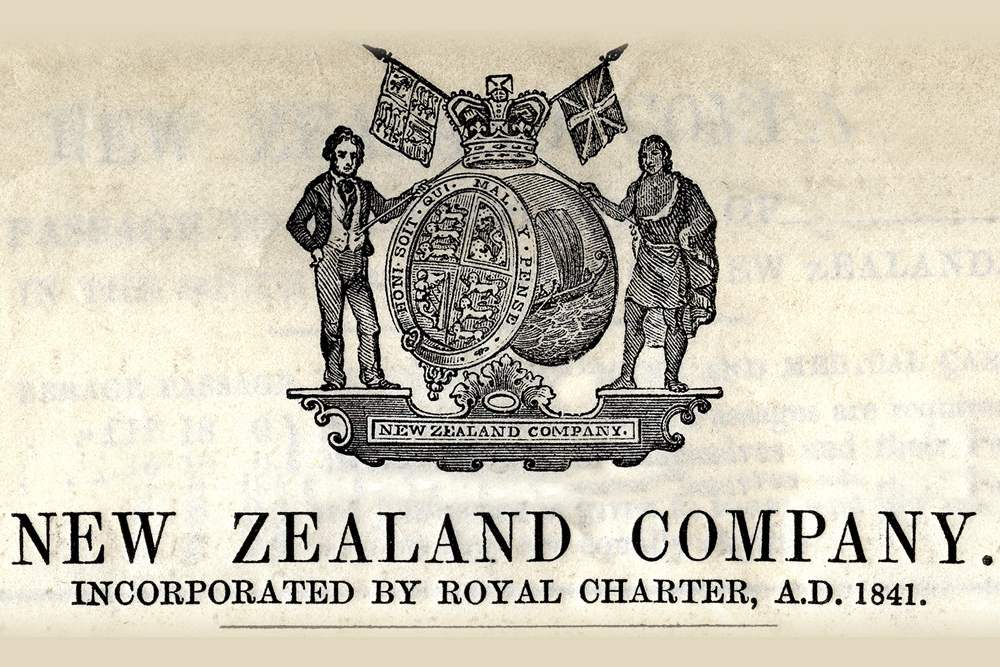
New Zealand Company Incorporated – Date 1841
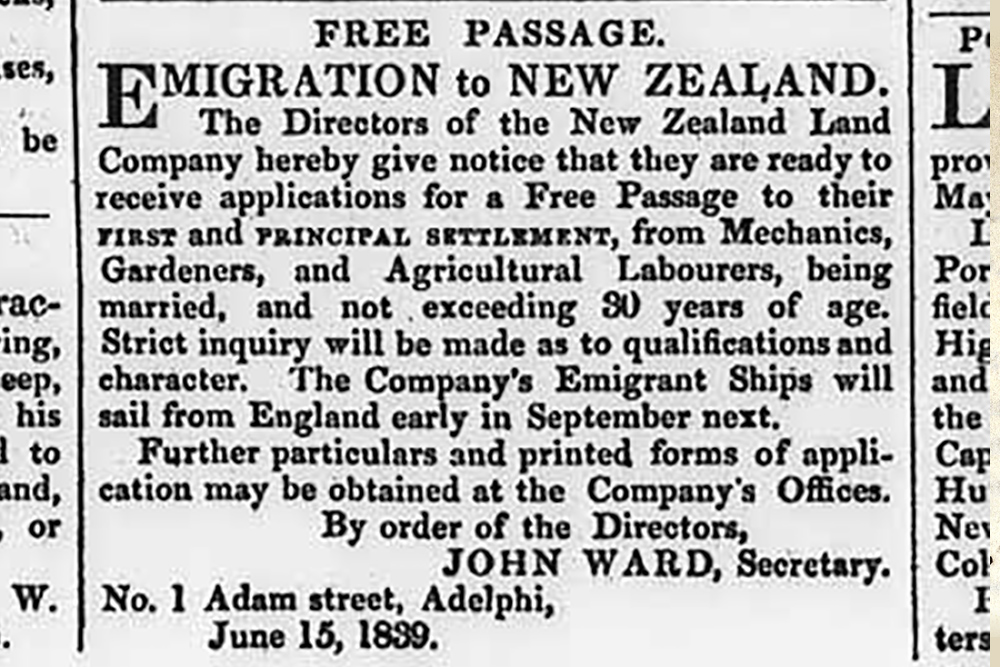
News article dated June 19 1839
As a result of debt escalating, shortage of funds and failure of the Native Land Court to determine titles on land blocks, the Crown only purchased a small portion of the Pātetere lands.
In 1879, the new government decided not to pursue the purchase of Pātetere lands and in January 1880 the Minister of Native Affairs indicated to one group of Auckland financiers and their agents that the Crown would withdraw from purchasing Pātetere once the money it had advanced to Māori had been recouped. The Government wanted the advances paid to Raukawa and its earlier purchase of the private interests in this land repaid in cash or in land. In calculating what Raukawa owed, the Government included other costs in addition to advances made to Raukawa, including portions of the salaries of its agents and it repeatedly refused to show its accounts to Raukawa.
By 1881, the Crown lifted all restrictions on private dealings in Raukawa lands, leaving Raukawa to the predations of large syndicates and speculators. As a result, by the late 1880s Raukawa lands alienated by sale topped 441,703 acres.
Raukawa land alienations continued into the 20th century as the Crown applied the Public Works Act.
20th Century Pressure/Pouakani – Nigel Te Hiko
In fact, the Public Works Acts in conjunction with the Native Lands Acts of the 1880s and 1900s had significant adverse effects on the iwi, the subsequent recovery from these Acts has been a long and difficult struggle.
The 1928 Public Works Act provided for the return of lands no longer required for public works, but later amendments discriminated against Raukawa and other Māori by excluding iwi lands from an offer back clause and allowed it to be used for “secondary purposes”. Those lands offered back under the Act were often beyond the financial capacity of the iwi to purchase, thereby prejudicing Raukawa from development of the land.
Raukawa lands along the upper Waikato River were taken under the Acts including various wāhi tapu sites, papa kāinga, urupā and other wāhi taonga within the takiwā. Much of the takings were affected with limited consultation or without notification, which severely prejudiced Raukawa whānau, hapū and the iwi.
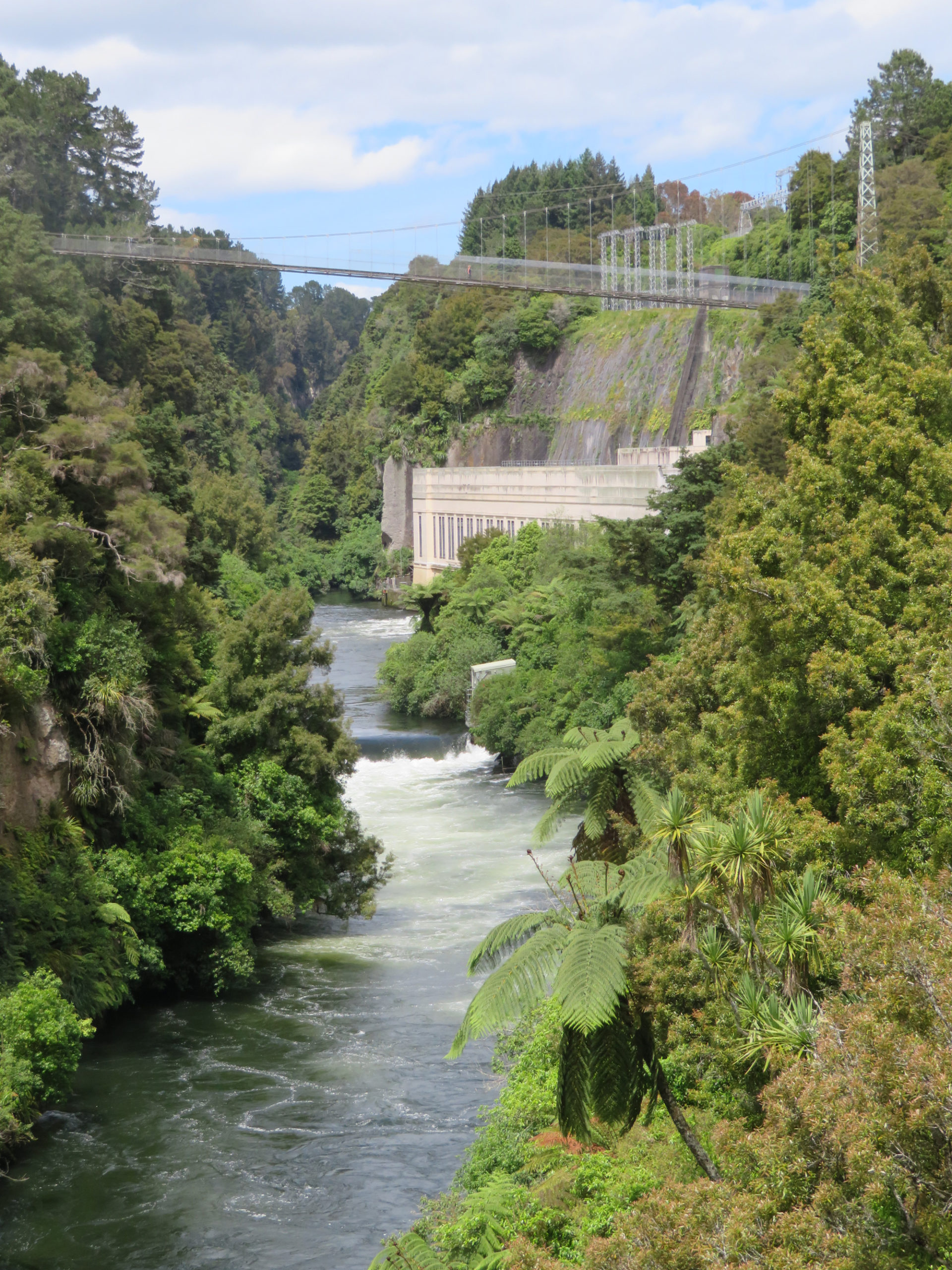
The Arapuni hydroelectric power station, completed in 1929.
One of the most significant Crown breaches was the loss of Raukawa ownership of what became known as the Pouakani block.
This resulted from various Crown purchasing practices and the works of the Native Land Court. This action meant the loss of 20,000 acres from Raukawa and the land exchanged in 1915 between the Crown and the Wairarapa people.
During the mid-20th century, the Crown undertook significant hydroelectric development along the Waikato River. This included the construction of seven dams up and down the river
During this time, with the increased infrastructure within what was once difficult to access lands, some Wairarapa people began to settle within the area. The presence of another iwi with no ancestral connection to the land being gifted Crown title of what was once Raukawa lands has been a significant and ongoing hurt to Raukawa.
This hurt compounded the effects of other harms that Raukawa were already suffering such as the loss of tribal identity, language and the diminishing of the iwi economy.
In 1999, representatives of the original owners of the Pouakani Block, (which included Raukawa members) signed a Deed of Settlement to address particular grievances arising from the impact of the Native Land Court and Crown having purchased land in this block. However, this settlement did not address issues associated with the Wairarapa Moana land swap. As a result, issues associated with the Pouakani block had to be picked up again by the RTB and continued into the wider settlement negotiations.
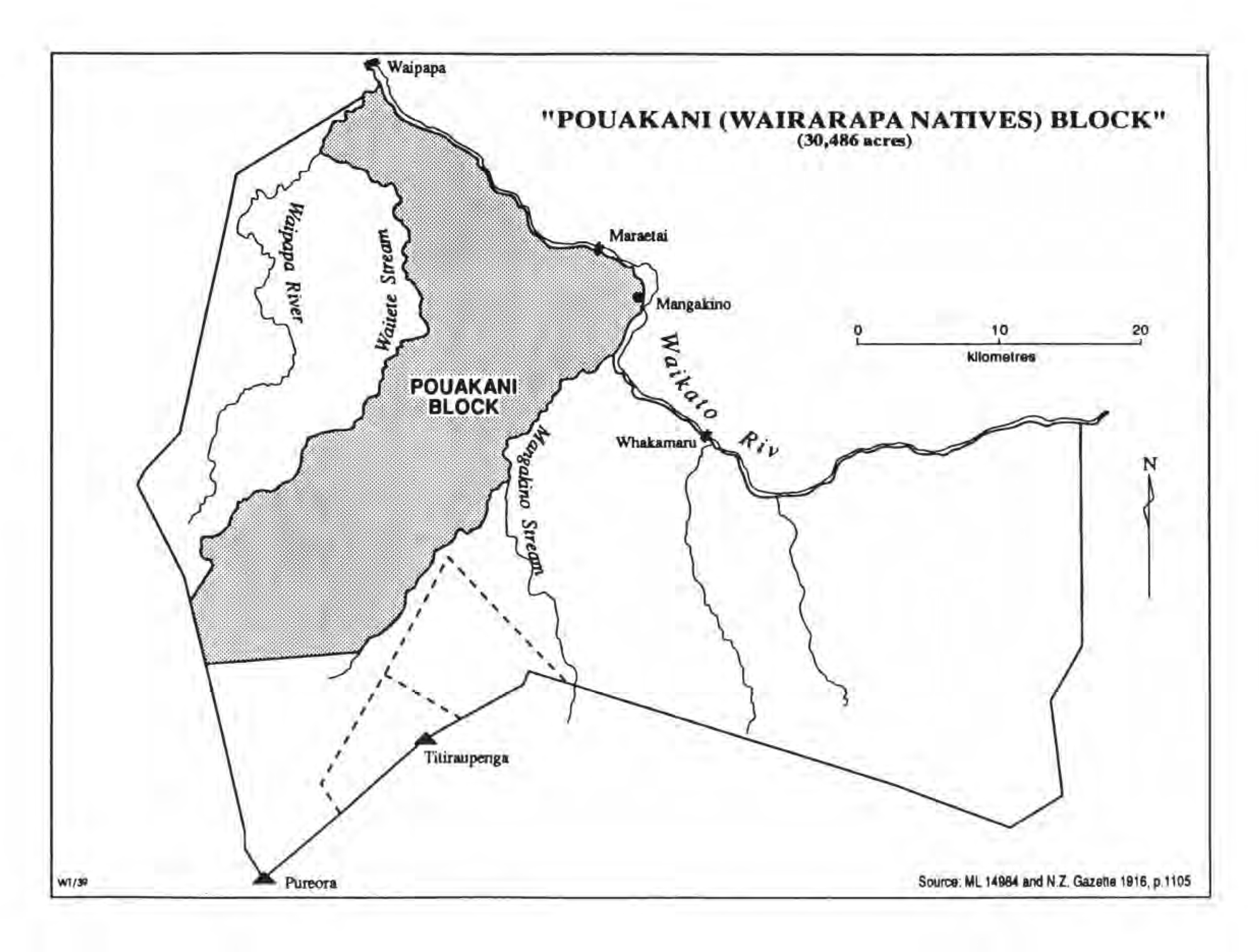
Pouakani Block
‘The Pouakani Report 1993 / Image courtesy of the Department of Justice
Throughout the 20th century, the Crown built several Hydroelectric Power Scheme developments along the Waikato River from Taupō through to Karāpiro.
The first of these was a privately built dam at Horahora in 1913 and then at Arapuni in 1929. In 1947, the Karāpiro Dam was commissioned followed by Whakamaru in 1956.
From a Raukawa perspective, the Crown’s weighting towards national interests rather than the specific interest of Iwi in a fair and equitable manner, resulted in the alienation of significant acres of Raukawa land. The Hydro-Electricity Power Scheme developments submerged Raukawa lands containing a number of Raukawa wāhi tapu, urupā, papakāinga and farmland by altering the flow of the upper Waikato River.
The impact of the Hydro-Electric Power Schemes in the Raukawa Rohe has seen the significant degradation to flora and fauna. It also meant the destruction of Raukawa traditional wāhi and resources including mahinga kai, such as tuna because of the change in the natural flow of the River and build-up of nitrates from surrounding agriculture.
20th Century Pressure/Hydro Electricity – Nigel Te Hiko, Miriata Te Hiko
In addition, while compensation was available and granted to farmers in Karāpiro, Raukawa people who applied for compensation for submerged land were not considered by the Crown as being important and of value to the national interest. This was the case in respect of a Raukawa whānau, evicted from their home and lands at Orakei Korako as a direct result of the building of the dam at Ōhākurī.
In the late 1950s, the government’s hydro-generation scheme extended to include the building of a dam at Ōhākurī, south of the village of Atiamuri. The government expected that the rising waters of the Waikato River would destroy the tranquil settlement of Orakei Korako, where the Wharekawa whānau had lived and worked for generations. The government acquired the land under the Public Works Act forcing the whānau to leave.
Kahurangi stated
“I was a young woman when my parents were informed by members of the Ministry of Works that the Waikato River would be raised as a result of the dam at Ohakuri. The officials told my parents that the land at Orakei Korako would be flooded and that our house, our home would be destroyed. As a result of the dam being built, my parents were forced to move from Orakei Korako. My parents were both elderly at this time.
The compensation offered to them by the government was inadequate to house them and provide for their needs.
My parents were offered housing in Ministry of Works camps in Rotorua and Mangakino, however government officials running the camps called them ‘Cuckoos’ because they believed them ‘undesirable to have in their camps’.
My father refused to move from Orakei Korako and was taken from his home late at night and placed on the back of a Ministry of Works truck. The last sight he saw was of his home being set ablaze by a government official. He was distraught as driving away he watched his house burn to the ground.
My parents were promised a home to move into. This however turned out to be a rental property in Taupō. For the first time in their lives, my parents had to pay rent, a concept that they did not fully understand. They were both elderly, living on a small pension with no other money to help supplement their income.
I remember my parents’ heartbreak as they passed away in a home that was not theirs.”
The following timeline charts the progression of Raukawa as an Iwi
1840
Jan 6
Henry Williams CMS climbs top of Mt Pohaturoa. Holds first sermon in the area at Atiamuri. A whare named “Rongopai” is built commemorating event.
Feb 6
Central North Island Raukawa do not sign the Treaty of Waitangi.
1853
Raukawa ki te tonga chiefs Mātene Te Whiwhi and Tamihana Te Rauparaha seek support for the establishment of a Māori King. Begin a series of hui-ā-iwi to choose a King.
1856
At a hui- ā-iwi at Pukawa, Pōtatau of Waikato is nominated to be King. Raukawa support his nomination.
1858
Pōtatau crowned first Māori King. Raukawa chiefs are among his closests advisors. Paerata warns Pōtatau of the Crown’s intention to build roads and to survey the Rohe Pōtae.
1863
Crown invades the Waikato. Raukawa remain apart from the conflict as northern Waikato refugees flood into the area.
1864
Feb 21
Crown attacks the peaceful village of Rangiaowhia killing women and children. While seeking refuge in a church, the church catches fire with the people trapped inside.
March 31
Crown attacks the unfinished pā at Ō-Rākau. 300 Māori, men, women and children defend pā against 1500 elite imperial and colonial forces.
June
Raukawa join forces with Tauranga iwi to fight at Pukehinahina and Te Ranga. Raukawa continue to oppose Crown during the “Bush Campaigns” along the Kaimai.
1866
Crown introduce Native Land Court in the Raukawa takiwā. Maungatautari land block comes before the Cambridge Court. Raukawa are excluded from the Maungatautari titles resulting in decades long dispute.
1870
Native Land Courts suspended as a result of the presence of Te Kooti within the area. Te Kooti is tracked to Tāpapa, but eludes Crown forces thanks to aid from Raukawa allies. He hides in the Kaimai before returning to the safety of Te Urewera.
1891
Royal Commission into Taupōnui-a-Tia West block orders rehearing of case. Pouakani is reheard (excluding the 20,000 acres awarded to the Crown).
1915
Wairarapa Māori are swapped land at Pouakani 1 for Lake Wairarapa and associated lands. Wairarapa Māori do not move onto land.
1940
Crown commences hydro-electricity development schemes along the Waikato River. Dams are built and lands are flooded.
1950
Marae dam and support town at Mangakino built. Wairarapa Māori move onto lands at Pouakani.
1987
Raukawa Trust Board established by Raukawa kaumātua.
1989
Wai 443 claim lodged.
2008
Raukawa sign the CNI Forest Deed of Settlement at parliament.
2009
Raukawa Settlement Trust established. Raukawa receive redress from the CNI deal. -Raukawa sign the Waikato River Co-Management deal at Whakamaru.
2010
Raukawa hold the Puāwaitanga o Raukawa; Raukawa Reconciliation Day with Minister Finlayson and local Member Louise Upston.
2012
June 2, Raukawa sign the Raukawa Claims Deed of Settlement.
2014
Raukawa Historical Claims Settlement Act passes into law.
